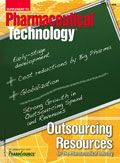News
Article
Pharmaceutical Technology
The Anatomy of the Changing Supply Chain
Author(s):
The high-profile case of contaminated heparin from a Chinese supplier has intensified the debate on the effectiveness of FDA's process for inspecting foreign drug-manufacturing facilities. The article examines proposed legislative and regulatory reforms and actions taken by the agency to improve drug-import safety.
The highly publicized recall of heparin resulting from adulterated product from a Chinese supplier earlier this year is helping to galvanize industry and political forces to seek reform in the US Food and Drug Administration's process for inspecting foreign drug-manufacturing facilities. The introduction of a discussion draft and Congressional hearings on the "Food and Drug Administration Globalization Act of 2008" in April and May of this year is taking that debate to the next level by examining the funding, resources, and implementation of FDA's inspection process.
Planting the seed
Although recent Congressional and public focus has raised the level of scrutiny for FDA's process for inspecting drug-manufacturing facilities, a myriad of industry and governmental groups have weighed in on the debate during the last several years.
SOCMA. In September 2006, the Bulk Pharmaceuticals Task Force (BPTF), an affiliate of the Synthetic Organic Chemical Manufacturers Association (SOCMA), submitted a citizen petition to FDA requesting that the agency increase inspections of drug-manufacturing facilities located outside of the United States. SOCMA is the US-based trade association representing batch and custom manufacturers. SOCMA's BPTF is an industry-trade organization of US manufacturers of active pharmaceutical ingredients (APIs), pharmaceutical intermediates, and excipients.

ALLAN BAXTER
The petition offered data to show the disparity in inspections of domestic and foreign drug-manufacturing facilities. In 2004, 3300 domestic and 2700 foreign drug-manufacturing facilities were registered with FDA. (These figures exclude 4500 domestic sites registered solely for the production of medical gases). China and India led in the number of registered sites with 440 and 300 sites, respectively. Approximately 51% of the registered foreign sites were API manufacturing sites. The remaining sites were other establishment types such as finished-dosage plants and control laboratories. The petition also cited that 87% of the 510 drug master files filed with FDA in fiscal year (FY) 2004 were for products and APIs manufactured outside the US (1).
The petition outlined recommendations for improving FDA's ability to reduce the risks from drug products imported into the US. These recommendations, as outlined below, were also presented in Congressional hearings in November 2007:
- Ranking foreign and domestic drug-manufacturing firms together to determine inspections. FDA maintains two lists: one foreign and one domestic, and mainly inspects domestic firms. By merging the lists, foreign firms that have a higher risk profile would be inspected before a US firm with a much lower profile.
- Listing "foreign facility" as a significant risk factor for determining facility inspections
- Creating a program to monitor the impurity profiles of imported over-the-counter (OTC) drugs for patterns creating the appearance of underlying problems in complying with current good manufacturing practices (CGMPs) to allow FDA to refuse entry to products appearing adulterated. This would allow FDA to see if impurity profiles for a facility change over time, which would show that a facility does not have control processes in place and would warrant an inspection (1).
EFCG. The European Fine Chemicals Group (EFCG) joined SOCMA in its efforts in seeking to reform FDA's inspection process. EFCG was formed in 2004 to address the competitiveness of European fine-chemical companies. EFCG is part of the European Chemical Industry Council, the Brussels-based trade association representing European chemical manufacturers.

Inspection fees and country-of-origin labeling
SOCMA and EFCG issued a joint position paper in October 2006 to highlight the lack of inspections occurring in foreign-drug manufacturing facilities, a situation particularly affecting APIs in generic and OTC drugs. "In 2005, FDA conducted 163 inspections of foreign API manufacturers, of which 14 (9%) of the API inspections were in China, 23 (14%) were in India, which is not proportional to the quantity of API being imported," said the SOCMA-EFCG position paper (2). The groups estimate that more than 80% of APIs used by US manufacturers are imported, with about half of the imported volume originating from India and China (2).
Government Accountability Office. The US Government Accountability Office (GAO) issued reports in November 2007 and April 2008 to evaluate FDA's program for inspecting foreign drug-manufacturing facilities (3, 4). GAO is an independent agency that works on behalf of Congress. GAO earlier reported on this issue in 1998, when it cited problems with the frequency, number, and rigor of foreign inspections by FDA (5).
In its November 2007 report, GAO reported that using a list of 3249 foreign facilities that FDA had prioritized for inspection, FDA may inspect about 7% of foreign establishments per year. Of these 3249 foreign facilities, there were 2133 foreign facilities for which FDA could not identify a previous inspection. Of the remaining 1116 foreign facilities on FDA's priority list, 242 had received at least one inspection, but had not received a GMP surveillance inspection since FY 2000 (3).
GAO found that most of FDA's inspections of foreign facilities are conducted as part of the preapproval process (i.e., when processing a new drug application or an abbreviated new drug application), rather than as GMP surveillance inspections, which are used to monitor the quality of marketed drugs. "Although FDA used a risk-based process to develop a prioritized list of foreign establishments for GMP surveillance inspections in FY 2007, few such inspections are completed in a given year," specified Marcia Crosse, GAO's health care director, to the House Subcommittee on Oversight and Investigations of the Committee on Energy and Commerce. (3). According to GAO, FDA conducted 332 inspection of foreign drug-manufacturing facilities in FY 2007, which was an improvement compared with FY 2006, when FDA conducted 212 inspections of foreign drug facilities, and with FY 2005, when FDA conducted 266 inspections (3).
GAO provided additional data to illustrate the disparity in the number and type of inspections (preapproval or GMP surveillance) between domestic and foreign drug-manufacturing facilities. From FY 2002 through FY 2007, FDA conducted 1445 foreign inspections: 1177 of these inspections included a GMP component, of which 998 were conducted in conjunction with a preapproval inspection. In contrast, FDA conducted 9694 inspections of domestic facilities that included a GMP component, of which 7742 were not conducted with a preapproval inspection (3).
GAO cited other problems in FDA's inspection process:
- A lack of dedicated staff for foreign inspections
- Making announced rather than unannounced GMP surveillance inspections of foreign drug manufacturers. Domestic manufacturers are subject to announced inspections.
- A lack of flexibility to extend foreign inspections if problems arise
- A lack of translators for inspection teams (3).
GAO also relayed concerns over FDA's information technology infrastructure and databases of manufacturing facilities in being able to provide an accurate count of foreign establishments subject to inspection (4).
Responding to these issues, federal agencies initiated reforms, and Congress developed a discussion draft and held hearings this spring for purposes of considering legislation to improve FDA's inspection process.
Taking action
Intragency Working Group on Import Safety. The Interagency Working Group on Import Safety was established in July 2007, under an executive order by the Bush Administration, to conduct a comprehensive review of current import-safety practices for drug, food, and consumer products, and to determine where improvements could be made. The Working Group, chaired by Health & Human Services (HHS) Secretary Mike Leavitt, evaluated steps that could be taken in the exporting country, US importing companies, and by federal, state, and local governments to address problems regarding imported products (drugs, food, and consumer goods). On Nov. 6, 2007, the Working Group issued an Action Plan for Import Safety: A Roadmap for Continual Improvement that contained 14 broad recommendations and 50 specific short- and long-term action steps to enhance the safety of the increasing volume of imports entering the US (6). The following list highlights drug-safety measures taken by FDA since the issuance of the action plan and measures taken under FDA's "Beyond Our Borders" initiative, a multipronged approach to promote and verify compliance in medical products, food, and cosmetics (6–9):
- FDA received approval and hired leadership for a new office in China, which will include 13 staff members (8 FDA personnel and 5 foreign nationals). The staff is responsible for building closer working relationships with FDA's Chinese counterparts, carrying out inspections, and working with Chinese inspectors to provide training.
- FDA signed memoranda of agreements (MOAs) with China's State Food and Drug Administration to facilitate broader access to Chinese production facilities on an expedited basis. FDA held bilateral talks with Chinese regulatory agencies to work toward creation of a certification program to help ensure items exported to the US meet HHS and FDA safety standards. Additionally, these MOAs provide a streamlined process for facilitating FDA inspections conducted in China. Senior officials from China and the US will meet annually to discuss and review progress on the MOAs.
- FDA plans to increase its field and international inspection operations. Its goals for FY 2009 include increasing foreign and domestic inspections and sampling, improving its laboratory infrastructure, continuing developing tools for rapid analysis, and enhancing its in-country presence in China.
- FDA is working to establish collaborations with India
- FDA accompanied an HHS delegation to Vietnam to discuss a cooperative arrangement with the Ministry of Health covering food, feed, and medical products
- HHS announced a pilot program by FDA and its counterparts in the European Union and Australia to jointly plan, allocate for, and conduct inspections of drug-manufacturing facilities, initially focusing on API producers (10).
- FDA is providing training on US regulatory requirements and technical assistance to foreign regulators
- FDA is pursuing third-party certification to verify compliance with FDA requirements. These third parties may include foreign government agencies and independent agencies accredited by FDA or accreditation organizations recognized by FDA. This certification would complement, not supplant, FDA inspectional and regulatory activities.
- FDA plans to issue guidance on good importer practices to help importer ensure product safety
- FDA participated in the World Health Organization's International Medical Products Anti-Counterfeiting Task Force (IMPACT). IMPACT is coordinating action among countries to halt the production, trading, and selling of counterfeit medical products globally.
- FDA is working to improve its IT infrastructure. Projects include more effective solutions to ensure the accuracy and validity of data in its registration- and import- information IT systems, including the Bio-Informatics Board's efforts to establish accurate information on firms and their products. FDA also plans to better use risk-based information from the entire life cycle of imported products. These changes will be implemented during the next two years, with certain projects implemented beyond 2010.
- Closer cooperation with Customs and Border Protection (CBP), including plans for developing interdepartmental procedures for clearing and controlling shipments at ports of entry, colocating FDA and CBP at locations to improve coordination, and greater import–information sharing.
- FDA is working to facilitate the adoption of track–and–trace technology to identify and track a product along the product's life cycle.
Congressional action. In April 2008, the US House of Representatives Energy and Commerce Committee issued a discussion draft on the Food and Drug Administration Globalization Act of 2008 to address the funding and authority of FDA in regulating the safety of the country's drug supply. The discussion draft was designed to stimulate discussion in Congressional hearings and serve as basis for drafting legislation. The discussion draft builds on four other bills (H.R. 3610, H.R. 3624, H.R. 3115, and H.R. 3484) and investigations conducted by the House Committee on Energy and Commerce's Subcommittee on Oversight and Investigations, a report from FDA Science Board's Subcommittee on Science and Technology, the Administration's Food Protection Plan and Import Plan, and input from other stakeholders. The proposed measures include the following:
- Creating an up-to-date registry of all drug and device facilities operating within the US or exporting products to the US. These facilities would be required to register annually with FDA. Registration would require payment of an annual fee to cover the cost of FDA inspections.
- Requiring FDA to inspect foreign and domestic drug and device facilities every two years. Manufacturers would be prohibited from introducing a drug, drug ingredient, or device into interstate commerce until an initial facility inspection has occurred. Registration would be suspended for refusing, impeding, or delaying an inspection.
- Restricting entry of imports lacking certain compliance documentation. After a phase-in period, importers of drugs for commercial use who lack compliance documentation relating to identity, safety, and purity would be required to ship products only through ports of entry with federal testing laboratories.
- Requiring manufacturers of drugs and drug ingredients to test for contaminants
- Allowing FDA to issue fines for violations of drug-safety requirements, extending FDA's authority to recall drugs and detain unsafe drugs discovered during inspections, and allowing FDA to destroy counterfeit or adulterated commercial imports
- Requiring drug labels to identify the source of the API and its place of manufacture and to require device labels to indicate the country of manufacture
- Creating a dedicated foreign inspectorate within FDA
- Prohibiting FDA from closing or consolidating any of the 13 field laboratories or 20 district offices that were operational as of Jan. 1, 2007 (11).
The draft legislation is still under consideration by Congress, as of press time.
References
1. "Petition to Request the Food and Drug Administration to Rank Foreign and Domestic Drug Manufacturing Firms Together for Purposes of the Agency's Risk-Based Approach to Inspections and Take Other Steps to Reduce the Public Health Risks Associated with Imported Drugs," Citizen Petition filed by the Synthetic Organic Chemical Manufacturers Association's Bulk Pharmaceutical Task Force to FDA (Washington, DC, 2006).
2. Synthetic Organic Chemical Manufacturers Association and European Fine Chemicals Group, "Joint Position Paper: Uneven Enforcement Leads to Sub-par Drugs and National Security Risks" (Brussels and Washington, DC, Aug. 2006).
3. M. Crosse, "Preliminary Findings Suggest Weakness in FDA's Program for Inspecting Foreign Drug Manufacturers," GAO-08-224T (GAO, Washington DC, Nov. 1, 2007).
4. M. Cross, "Preliminary Findings Suggest Recent FDA Initiatives Have Potential, but Do Not Fully Address Weakness in its Foreign Drug Inspection Program," GAO-08-710T (GAO, Washington, DC, Apr. 22, 2008).
5. GAO, "Improvements Needed in the Foreign Drug Inspection Program," GAO/HEHS-98-21 (Washington, DC, Mar. 1998).
6. FDA, "Action Plan for Import Safety: FDA Activities (November 2007–June 2008)" (Rockville, MD), http://www.fda.gov/oc/initiatives/advance/imports/activities.html, accessed July 14, 2008.
7. Interagency Working Group on Import Safety, "Import Safety–An Action Plan Update" (Washington, DC, July 2008).
8. J. Woodcock, "Discussion Draft of the Food and Drug Administration Globalization Act," statement before the Subcommittee on Health, Committee of Energy and Commerce, US House of Representatives (Washington, DC, May 1, 2008).
9. A.C. von Eschenbach, "FDA Actions to Improve Safety of Medical Products with Foreign Components," statement before the Subcommittee on Oversight and Investigations, Committee on Energy and Commerce, US House of Representatives (Washington, DC, Apr. 22, 2008).
10. US Department of Health & Human Resources, "HHS Announces New International Programs to Enhance Drug and Food Safety" (Washington, DC, Jul. 9, 2008).
11. US House of Representatives Energy and Commerce Committee, "Discussion Draft of the Food and Drug Administration Globalization Act of 2008" (Washington, DC, Apr. 2008), http://energycommerce.house.gov/FDAGlobalAct-08/Dingel_60AXML.pdf, accessed July 14, 2008.

Newsletter
Get the essential updates shaping the future of pharma manufacturing and compliance—subscribe today to Pharmaceutical Technology and never miss a breakthrough.





